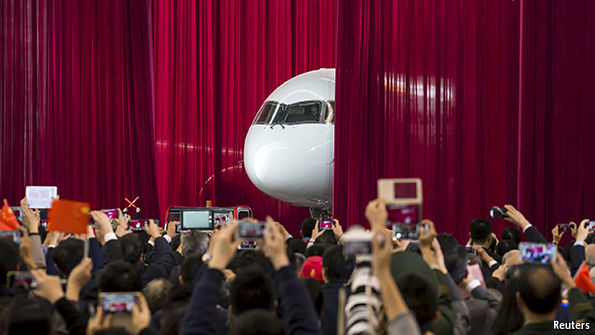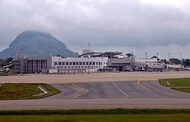SINCE the 1990s the global market for full-sized commercial airliners has been a duopoly. The market, which by some estimates will be worth $4.6 trillion over the next 20 years, is dominated by Airbus, a European firm, and Boeing, its American competitor. But in theory, at least, airlines will soon have a wider choice of planes. On November 2nd COMAC, a Chinese state-owned planemaker, revealed its C919 plane (pictured, next page), a competitor to Airbus’s A320 and Boeing’s 737, the two most popular airliners in the skies. COMAC says the C919 will have its maiden flight next year—two years later than first scheduled—and enter service around 2019.
The Chinese are not the only ones who think they can break the duopoly. After several delays, Irkut, part of Russia’s state-owned United Aircraft Corporation (UAC), hopes to launch its MC-21 aircraft, another potential rival to the 737 and A320, into service in 2017.
Many aviation analysts remain sceptical about whether these rivals, even with generous state backing, will ever put a significant dent in the bulging order books of Airbus and Boeing. The C919 will contain a great deal of Western-designed equipment—including its engines, until such time as China succeeds in a parallel venture to be a maker of world-class commercial-airliner engines. But analysts suspect that if and when it flies, its fuel efficiency will lag that of the newest versions of the Boeing 737 and Airbus A320.
And although the Russians and the Chinese may well be fairly good at designing aircraft, they have little experience in creating the complex production systems and supply chains needed to build them to the extremely high standards of reliability and safety that airlines expect. The need to improve their safety record will ensure that they are “not a near-term risk” for the likes of Boeing, says Jason Gurksy, an aerospace-industry analyst at Citigroup.
Even Bombardier of Canada, which has a good record of safety and quality for the smaller aircraft that it makes, has struggled to break into this lucrative market. Fewer than 250 of its much-delayed CSeries planes have been ordered. In contrast, Boeing has already delivered more than 8,700 of the 737 in its various incarnations, and has orders for a further 4,200.
It emerged recently that Bombardier had tried unsuccessfully to sell a stake in the CSeries project to Airbus. On October 29th Bombardier announced that the provincial government of Quebec, where the firm is based, would pay $1 billion for a stake of 49.5% in the plane, whose development has so far cost $5.4 billion.
Incumbents are just as hard to dislodge in the market for smaller “regional” jets (ones with up to around 100 seats), which is dominated by Bombardier and Embraer of Brazil, but which COMAC, UAC’s Sukhoi subsidiary and Mitsubishi of Japan are all trying to break into. COMAC’s regional jet, the ARJ21, had its first test flight in 2008, but because of concerns about cracks in its wings and dodgy wiring it has still not been certified for commercial flights in America. Mitsubishi’s MRJ and Sukhoi’s Superjet were also delayed by technical problems. The Superjet is now in service with a handful of airlines, though orders have been sparse; and the MRJ may make its maiden flight shortly.
To be fair, the giants of the industry also find that it is not easy to get an entirely new aircraft design off the ground. The research-and-development costs for Boeing’s newest aircraft project, the 787 Dreamliner, grew to $28 billion as a result of problems with its supply chain and electronics. And revenues from one of Airbus’s newest aircraft, the giant A380, hardly cover its production costs, never mind the capital sunk into its development. If even the industry’s two dominant firms find it a long, expensive struggle to get a new aircraft design in the sky, no wonder their would-be rivals are having such a hard time.
(The Economist)














